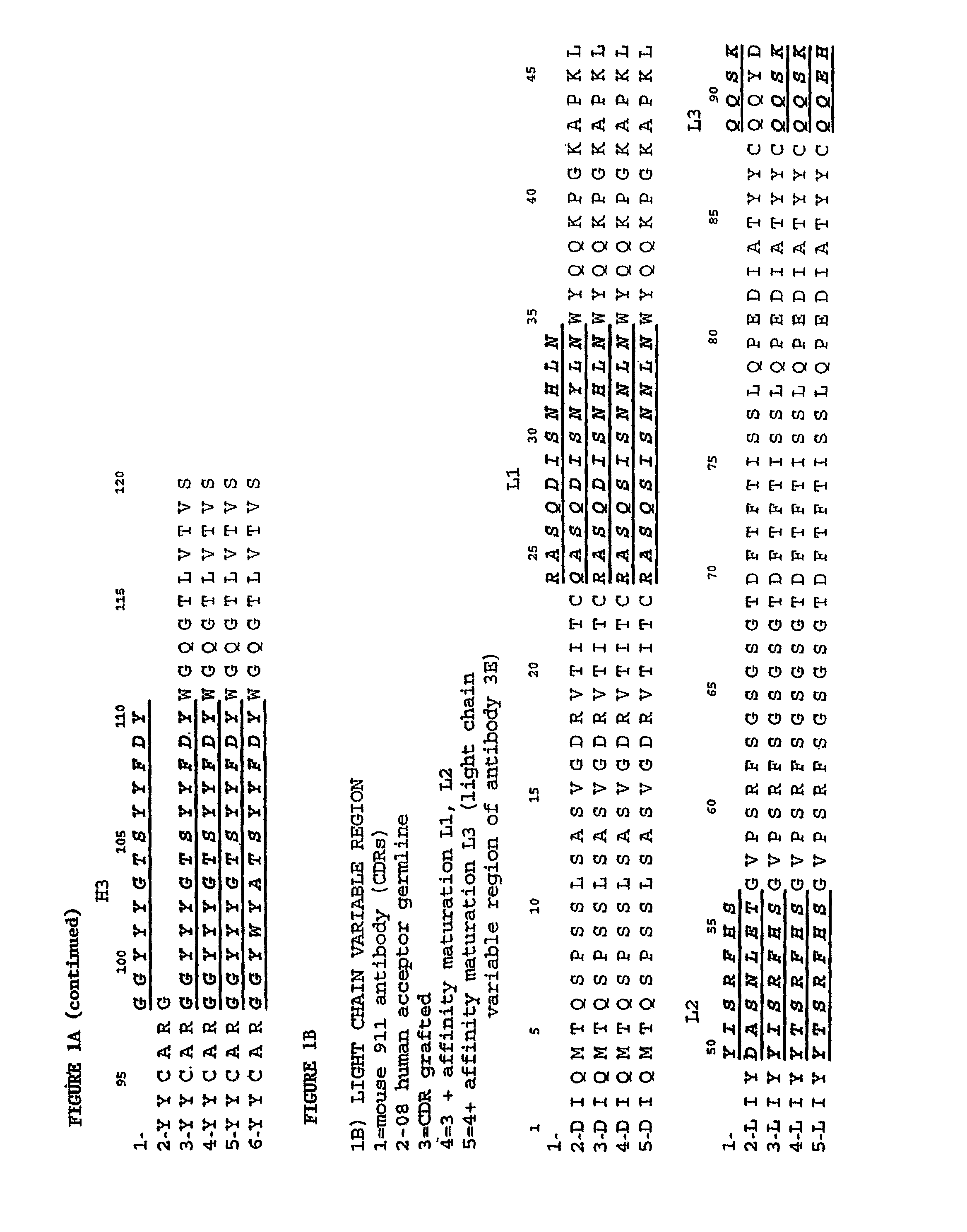Methods for treating osteoarthritis pain by administering a nerve growth factor antagonist and compositions containing the same
a nerve growth factor and antagonist technology, applied in the field of anti-antingf antibodies, can solve the problems that the effector function of mouse antibodies has been less efficient in the human context, and achieve the effects of suppressing osteoarthritis pain, and reducing the incidence of osteoarthritis pain
- Summary
- Abstract
- Description
- Claims
- Application Information
AI Technical Summary
Benefits of technology
Problems solved by technology
Method used
Image
Examples
example 1
Humanization and Affinity Maturation of Mouse Antagonist Anti-NGF Antibody 911
[0376]A. General Methods
[0377]The following general methods were used in this example.
Library Generation
[0378]Libraries were generated by PCR cassette mutagenesis with degenerate oligonucleotides as described in Kay et al. (1996), Phage display of peptides and proteins: a laboratory manual, San Diego, Academic Press (see, pages pg 277-291). The doping codon NNK was used to randomize one amino acid position to include 20 possible amino acids. To randomize one amino acid position to include only a subset of amino acids with specific properties, doping codons were used as described in Balint et al, (1993) Gene 137(1):109-18). Site directed mutagenesis was performed using recombinant PCR as described in Innis et al, (1990) PCR protocols: A guide to methods and applications (see, pp. 177-183).
Small Scale Fab Preparation
[0379]Small scale expression in 96 wells plates was optimized for screening Fab libraries. St...
example 2
Evaluation of NGF-Blocking Ability of Anti-NGF Antibodies Using Mouse E13.5 Trigeminal Neuron Survival Assay
[0454]The ability of Fab E3 or full antibody E3 to block NGF activity was evaluated by measurement of the capacity of the antibody to inhibit NGF-dependent survival of mouse E13.5 trigeminal neurons in vitro. The trigeminal ganglion is comprised of cutaneous sensory neurons that innervate the facial region. The survival of mouse E13.5 trigeminal neurons is a sensitive assay to evaluate the NGF-blocking activity of anti-NGF antagonist antibodies because NGF is required to support survival of these neurons. For example, at saturating concentrations of NGF, the survival is close to 100% by 48 hours in culture. By contrast, less than 5% of the neurons survive by 48 hours in absence of NGF.
[0455]The survival assay was conducted as follows: time-mated pregnant Swiss Webster female mice were euthanised by CO2 inhalation. The uterine horns were removed and the embryos at embryonic sta...
example 3
Evaluation of the Specificity of Anti-NGF Antibody E3 Using Mouse Trigeminal and Nodose Neuron Survival Assays
[0464]The ability of antibody E3 to specifically block NGF activity was evaluated by measurement of the capacity of the antibody to inhibit survival of mouse E17 / 18 trigeminal neurons in vitro in the presence of saturating concentrations of NGF, the NGF-related neurotrophin NT3, or the NGF-unrelated neurotrophic factor, macrophage stimulating protein (MSP). The survival of mouse E17 / 18 trigeminal neurons is a sensitive assay to evaluate the NGF-blocking activity of anti-NGF antagonist antibodies because NGF is required to support survival of these neurons at higher concentrations than the level of NGF required to support survival of E13.5 TG neurons). Survival of these neurons is also supported by NT3 or MSP; therefore, the survival of these neurons is also a sensitive assay to evaluate whether the anti -NGF antagonist antibody also blocked NT3 or MSP.
[0465]The ability of an...
PUM
| Property | Measurement | Unit |
|---|---|---|
| temperature | aaaaa | aaaaa |
| pH | aaaaa | aaaaa |
| temperature | aaaaa | aaaaa |
Abstract
Description
Claims
Application Information
 Login to View More
Login to View More - R&D
- Intellectual Property
- Life Sciences
- Materials
- Tech Scout
- Unparalleled Data Quality
- Higher Quality Content
- 60% Fewer Hallucinations
Browse by: Latest US Patents, China's latest patents, Technical Efficacy Thesaurus, Application Domain, Technology Topic, Popular Technical Reports.
© 2025 PatSnap. All rights reserved.Legal|Privacy policy|Modern Slavery Act Transparency Statement|Sitemap|About US| Contact US: help@patsnap.com



